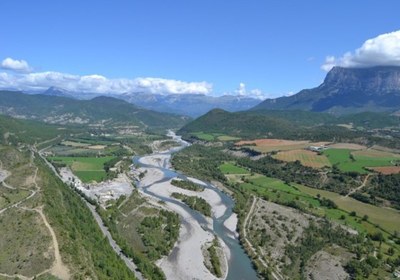Biodiversity Fundation Project
Justification of the project
The Weighted Usable Area (WUA) for fishes is a known parameter for the assessment of the ecological state of rivers. Additionally, the Ecological Discharge Regime (EDR) is a requirement of the Water Framework Directive and the Hydrological Planning Instructions for a better management of the water resources.
The high cost of field works and data collection in particular zones in rivers has pushed the development of new tools for eco-hydraulic modelling. The existing tools do not use the newest hydraulic simulation techniques and the results are conditioned to the expertise of the user and its use is limited by difficulties of its management.
The development of a Hydrobiological module in Iber will allow to evaluate the WUA and to estimate in a - efficient way (homogesnously and fast) - the EDR based on a hydraulic, physical-chemical, hydromorphological and hydrobiological criteria.

Objectives
The development, validation and implementation of a new tool in Iber for the calculation of the Physical Suitability Habitat (PSH) and the Weighted Usable Area (WUA) for different regulated or no-regulated fish species in rivers .

Team
The team will consist of a multidisciplinary Flumen Institute members . This project will be carried out in collaboration with the Group Rius research group.
Results
This new tool can serve to improve the criteria in the decision making of water resources management, in general, and to improve the current state of the rivers, in particular, promoting strategies that promote environmental conservation in rivers, enhancing all ecological and biological aspects.
In this section some partial results of the project will be shown:
| Field campaing | |
|---|---|
 |
|
| Pre-process interface | ||
|---|---|---|
 |
 |
 |
| Post-process interface | ||
|---|---|---|
 |
 |
 |
| Some results | ||
|---|---|---|
Have a look to some publications performed in the project framework:
- Sanz-Ramos, M., Bladé, E., Alcázar, J., Palau, A., 2018. Application of iber hydraulic simulation model for assessing physical habitat suitability (wua) for fish. In proceedings of 12th ISE 2018, Tokyo, Japan.
The key reference of the new module entitled IberHABITAT has been published in RIBAGUA international journal (open access!). Have a look to the manuscript (Spanish speech) o use this citation for reference it:
- Sanz-Ramos, M., Bladé, E., Palau, A., Vericat, D., Fuertes-Ramos, A., 2019. IberHABITAT: evaluación de la Idoneidad del Hábitat Físico y del Hábitat Potencial Útil para peces. Aplicación en el río Eume. Ribagua, 1-10. DOI: 10.1080/23863781.2019.1664273
Transfer of Technology
It is expected that this tool may be useful for improving criteria under the decision making for the water resource management and to improve the current state of the rivers promoting strategies for the environmnental conservancy of water bodies empowering biological and ecological aspects.
Under the philosophy of the team and the program for the diffusion of the Iber model this new tool will be open to be used by everyone. Considering that Iber is a free program, the new model will follow the same path and it will be available at the www.iberaula.es after the closure of the project.
- Download for free the program here.
Besides, in order to improve the transfer of technology to the society, a workshop and a basic training will be organized were the new tool will be presented. This event will be divided in three parts: first a technical and scientific presentation about the Physical Suitability Habitat (legislation, etc.) followed by a short course of hydraulic modelling with Iber and finally the presentation and training of the new tools (modules) developed by the project (OPE and WUA).
More info about:
- Workshop: http://www.iberaula.es/1075/iber-community/workshops
- Training: IberHABITAT course
Funding
The project is supported by Fundación Biodiversidad of the Ministry for the Ecological Transition under the call for “Concesión de ayudas, en régimen de concurrencia competitiva, para la realización de actividades en el ámbito de la biodiversidad terrestre, biodiversidad marina y litoral 2017”.


Share: